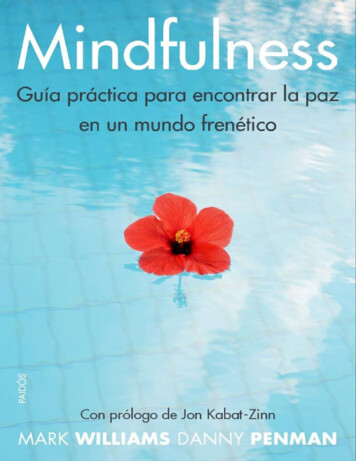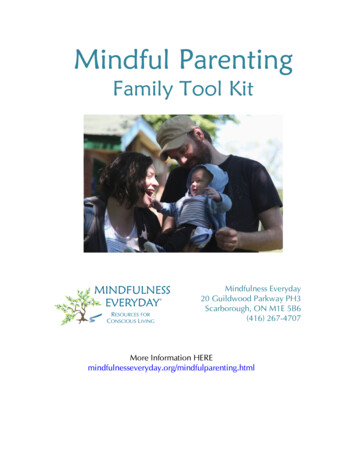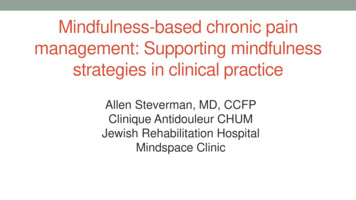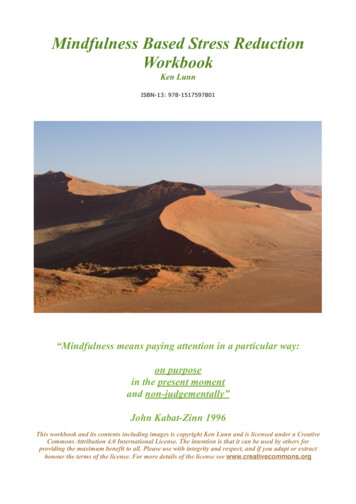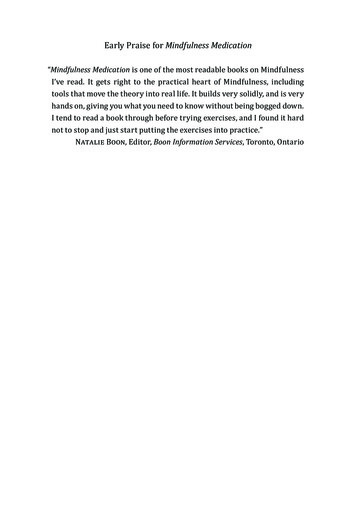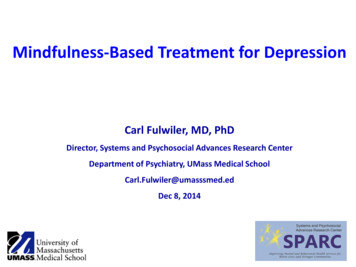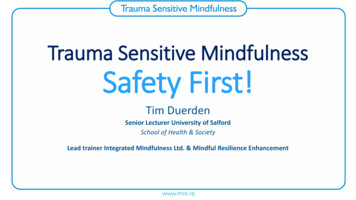
Transcription
Trauma Sensitive MindfulnessSafety First!Tim DuerdenSenior Lecturer University of SalfordSchool of Health & SocietyLead trainer Integrated Mindfulness Ltd. & Mindful Resilience Enhancement
Mindfulness Definition:‘Mindfulness means paying attention to what’shappening in the present moment in the mind, bodyand external environment, with an attitude of curiosityand kindness.’ The Mindfulness Initiative, 2015, p.6 Reflect on this definition as if mindfulness is new to you. How might someone with a history of trauma feel challengedby what is required to be mindfully aware? Have there been experiences in your life where being ‘fully’ mindfully awarewould not have been kind to yourself?The Mindfulness Initiative (2015). Mindful Nation UK Report by the Mindfulness All-Party Parliamentary Group. Retrieved 10 February, 2016, reports/Mindfulness-APPG-Report Mindful-Nation-UK Oct2015.pdf3
Mindfulness: does it feel safe? Is the present moment safe to notice or overwhelming? Does my mind feel safe to notice? Does my body feel safe to notice? Does the external environment feel safe to notice? Have I experience of curiosity being safe? Do I associate kindness with safety? Does kindness to self feel safe to experience?If I do not feel safe, what do I do to get through this moment?4
Mindfulness: Awareness vs Practice Mindfulness practice cultivates mindfulness awareness. The cultivation of mindfulness awareness is, implicitly or explicitly,part of the process of trauma recovery. Meeting the experience of past trauma as it is, with kindness and curiosity, isessential for trauma recovery.5
Mindfulness: Awareness vs Practice Depending on the appropriateness of the practice for the individual’sneeds, mindfulness practices may be: Detraumatising – help integrate traumatic experiences, promoting healing. Re-traumatising – trigger trauma memories and feelings in a way thatreinforces the traumatic experiences and undermines healing. Traumatising in their own right – new traumatic experiences result from themindfulness practice. Practice context and structure are critical. For example: Mindfully walking the dog vs slow group mindful ‘zombie’ walking. Mindfully tensing and loosening foot and hand muscles with eyes open in achair for 10 minutes vs a 45 minute body scan lying down on the floor on yourback with eyes closed in a group in session 1.6
The Transaction Model of Stress: StressLazarus, R. & Folkman, S. (1984) Stress, appraisal, and coping. New York: Springer Pub7
The Transaction Model of Stress: Coping8
The Transaction Model of Stress: Resilience9
10
Trauma Sensitive Mindfulness Teaching: Has mindfulness practices that are experienced as being largely within theparticipants’ Window of Tolerance. Experience outside Window of Tolerance typically reinforces existing learnedbehaviours that gets the person through – but at what long term cost? Participants are unlikely to be practicing mindfulness when outside their Window ofTolerance. Establishes practices that are steadying before introducing practices thataim to stretch the Window of Tolerance. Many mindfulness programmes have session 1 content that requires the verymindfulness and self-soothing skills to mindfully practice that the whole course isdesigned to cultivate. Must accommodate individual differences in choice of focusing anchor andsupport participants opting out of any practice without shame.11
Graded Exposure: Care-Full Challenge The majority of psychotherapeutic approaches seek to help the clientestablish safety: Safety in the relationship with the therapist Safety in the learning experiences offered by the therapist More broadly this is the foundation of all effective learning Graded Exposure means starting from where there is some sense of safety(however small) and gradually increasing the level of challenge. This cultivates learned experiences of mastery and develops a sense of self-efficacy Effective learning happens when we are within our Window of Tolerance. Graded exposure starts with learning experiences that are within our Window ofTolerance Pendulation (Levine, 2010): swinging/dipping in-and-out of experiences that are justoutside out our Window of Tolerance is catalytic to effective learningLevine, P. A. (2010). In an unspoken voice: How the body releases trauma and restores goodness. North Atlantic Books.12
Suggested Requirements for Teaching Trauma SensitiveMindfulness Practice: Person-centred A collaborative curriculum and mindfulness practices adapted to, andemerging from, identified individual need Curriculum and practices continuing to be based on a process of cocreation between teacher and participants throughout the course Willingness to go at group’s pace rather than forcing the curriculum’space on the group13
Suggested Requirements for Trauma SensitiveMindfulness Practice: Safe Easily attainable, kind challenges Minimal risk of failure Maximum sense of personal choice No required home practice – especially not longer home practicesthat may require participants to give up other established self-careroutines to ‘carve out’ practice time (e.g. sleep, exercise, social life) No ‘just do it’ mentality!14
Suggested Requirements for Trauma SensitiveMindfulness Practice: Relational Teaching embedded in a trusting relationship with teacher and group Unpleasant, contradictory experiences of participants actively soughtin inquiry to minimise suffering in shamed silence15
Suggested Requirements for Trauma SensitiveMindfulness Practice: Scaffolded Practice grows from familiar experiences within accessiblepsychoeducational framework Explanations of what practices will involve before practiced Alternatives and options to adapt/opt out clearly explainedbeforehand No surprises – beginner’s mind is for seasoned practitioners! Short practice ‘test-drives’ before longer practices16
Suggested Requirements for Trauma SensitiveMindfulness Practice: Gradual Brief practices Immediate repetition after inquiry consolidates learning, enhancessafety Skills cultivated in small steps starting in low intensity, familiarcontexts Stabilising practices established before more challenging practicesoffered17
Suggested Requirements for Trauma SensitiveMindfulness Practice: Grounding Open eyed External senses before internal senses: looking / listening beforetasting / smelling beforeholding objects / contact points feet and sitting bones beforemoving feet/hands in time with breath beforebreath at nostrils beforebreath in the back / breath movements under hands beforebreath in general / torso as focus Multiple senses as anchor (e.g. looking, feeling (even hearing) as holdobject) Vivid sensory anchors that attract attention Movement during practice18
As mindfulness teachers, I believe we need to create a safelearning environment where the participants’ experience is:
Bessel van der Kolk: Trauma RecoveryThe challenge of [trauma] recovery is to re-establish ownership of your body andyour mind — of your self.This means feeling free to know what you know and to feel what you feel withoutbecoming overwhelmed, enraged, ashamed, or collapsed.For most people this involves:1.2.3.4.Finding a way to become calm and focused.Learning to maintain that calm in response to images, thoughts, sounds, or physicalsensations that remind you of the past.Finding a way to be fully alive in the present and engaged with the people around you.Not having to keep secrets from yourself, including secrets about the ways that you havemanaged to survive.Being able to feel safe with other people is probably the single most importantaspect of mental health. Safe connections are fundamental to meaningful andsatisfying lives.Van Der Kolk, B. (2014). The Body Keeps the Score. New York, NY: Viking.20
Trauma Sensitive Practice: (Treleaven, 2018)A programme, organization, or system that is trauma-informed: realises the widespread impact of trauma and understands potentialpaths for recovery; recognises the signs and symptoms of trauma in clients, families,staff, and others involved with the system; responds by fully integrating knowledge about trauma into policies,procedures, and practices; and seeks to actively resist re-traumatization.Treleaven, D. (2018) Trauma Sensitive Mindfulness. New York: W. Norton Publishers.U.S. National Center for Trauma-Informed Care. (2016). Trauma-informed approach and trauma-specific interventions. Washington, DC. Retrievedfrom 1
Mindfulness Definition: 'Mindfulness means paying attention to what's happening in the present moment in the mind, body and external environment, with an attitude of curiosity and kindness.' The Mindfulness Initiative, 2015, p.6 Reflect on this definition as if mindfulness is new to you.

